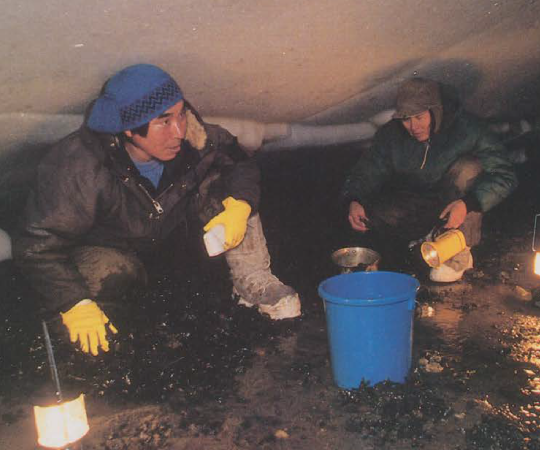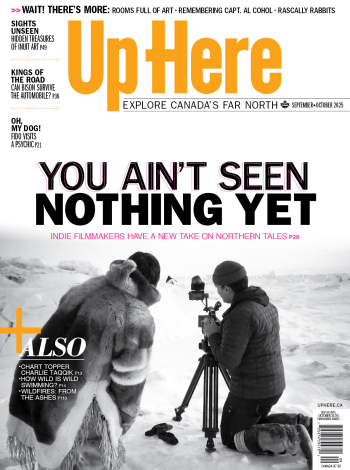This is the story of the past 35 years. This is the story of the North, as only Up Here could tell it.
The First Decade.
The Second Decade.

THE THIRD DECADE: 2004-2014
It was a hell of a photo op. A former Beatle, rolling around with an adorable baby seal on an ice floe. How could the international press not eat it up? Paul and Heather McCartney’s PR blitz in 2006 called the seal hunt a “stain” on Canada and snared celebrities from Ellen Degeneres to Pamela Anderson in its frenzy. It also had a devastating effect on the people who actually hunt, eat, and wear seal.
The European Union quickly put forward a proposal to ban all trade and import of seal products across their continent. Nunavut sealskin sales fell by nearly 90 per cent in 2008 alone, and still haven’t recovered. For families whose income depended on the sale of seal products, the results were dire. The average income of a seal hunter in Resolute Bay fell from $53,000 to $1,000.
Slowly the image of sealing in southern Canada has begun to evolve. In 2009, Governor General Michaelle Jean proudly chowed down on bloody seal heart during a visit to Rankin Inlet. Inuit artists like Laakkuluk Williamson Bathory, Nancy Mike, Tanya Tagaq, and Alethea Arnaquq-Baril fired back at Ellen Degeneres’ seal-hunt rhetoric in 2014 by launching the viral “sealfie” movement on social media.

In Up Here’s third decade the world was also quickly beginning to realize just how rapidly the climate was changing—and its very-real impact on northern lives. Rivers were drying up and permafrost was melting. The Bathurst caribou herd’s numbers were—still are—in free-fall. From 2006 to 2009, chinook salmon populations swimming up Whitehorse’s Fish Ladder shrunk by 75 per cent. Rapid development in Alberta’s oil sands prompted fears that toxic tailings could spill out and run north through the Athabasca River.
Scientists in 2013 confirmed that 30 per cent of the Arctic’s sea ice had melted over the past 35 years. Meanwhile, Inuit elders were reporting that the sun was in the wrong place. It was rising and setting in a different location. The visual shift was the result, scientists eventually realized, of a rapidly warming atmosphere refracting the solar light at a new angle.

Another northern legend that became real in the 2000s was the long-rumoured grolar bear. The grizzly-polar hybrids had long been speculated by hunters and observed by Inuit, but an actual specimen had eluded scientists until one was shot and killed in 2006 near Sachs Harbour. Trophy hunter Jim Martell had the corpse stuffed and shipped south to be displayed in his Idaho home.
In 2007, the Mad Trapper’s corpse was exhumed in Aklavik by DNA experts. A documentary crew filming their efforts hoped to determine the legendary criminal’s identity once and for all. No such luck, unfortunately. It was also the same year the Canada Winter Games came to Whitehorse. The National Energy Board approved the Mackenzie Valley pipeline project in 2010 after many years of regulatory review. The project’s cost would eventually balloon to $16 billion before its backers walked away in 2017.

The Wildcat Cafe in Yellowknife was put back together in 2012 after being dismantled so a new foundation could be poured. Every one of the landmark’s logs and nails was meticulously categorized so it could be reassembled—piece by piece— exactly as it always had been. That same year the Deh Cho Bridge finally opened, and RCMP officer Gregory Logan was issued a $385,000 fine after authorities uncovered his role in an international narwhal tusk smuggling ring.
In other news, the territories were growing—fast. Numbers from the 2006 federal census showed Canada’s north of 60 population had surpassed 100,000 for the first time ever. That doesn’t mean the cost of living was any easier. A 10-kilogram watermelon in Nain, Labrador priced at $55.41 became something of a local attraction in 2008, with residents snapping pics to post online. After CBC came calling the melon was reassessed at a more reasonable—relatively speaking—$38. In 2009 a frozen turkey selling for $200 in Arctic Bay again made the national news. It was eventually marked down to $90. Two years later the federal government created its Nutrition North subsidy program.

Meanwhile, there was something of a northern renaissance happening on cable TV. The History Channel stumbled upon ratings gold in 2007 with the premiere of Ice Road Truckers. A convoy of charismatic drivers hauling supplies across frozen lakes wound up setting a ratings record for the American channel, attracting 3.4 million viewers when it debuted. A number of northern-based reality shows quickly followed suit. There was the Discovery Channel’s Gold Rush, the Canadian History channel’s Yukon Gold and Buffalo Air’s breakthrough performance in Ice Pilots: NWT. Viewers couldn’t seem to get enough of rugged northerners engaged in rough-and-tumble careers.
The United States outlawed the importation of polar bear pelts in 2009, restricting another important revenue source for Inuit. Polar bear diamonds also came to an end at the start of the 2010s. The glittering brand of Canadian stones, once proudly worn by celebrities like Meryl Streep and Jodie Foster, disappeared when the only two cutting shops licensed to use the world-famous engraving went belly up by 2011.

Speaking of brands, in 2014 the city of Yellowknife aggressively forced a local artist to hand over $2,000 worth of t-shirts depicting the Wildcat Cafe in an effort to protect the heritage location’s trademark. The shirts were eventually returned after significant public backlash, so long as they weren’t sold to anyone.
Then in 2016, the head frame was brought down. The Robertson head frame at Con Mine was the tallest building in the Northwest Territories. For years it served as a landmark for pilots and sailors. Its red cap dominated the skyline as a visual reminder of the town’s mining heritage. But by 2016 it was an albatross for the city. Estimates put the annual upkeep of the site at $500,000. Yellowknife instead chose to spend that money to level the structure via controlled explosion.

Finally, in 2014, devolution came to the Northwest Territories. Government responsibilities had been handed over piecemeal to the territory since the ’80s, but the finalized Northwest Territories Devolution Act changed the landscape forever when it received Royal Assent in 2014 (eleven years after the Yukon had broken away from Ottawa). The NWT had control over its land, its resources, and its future. How all that works is still being figured out five years later.
Oh, and 2014 was also when the HMS Erebus was located. Franklin’s ship was found sitting in 10 metres of water off O’Reilly Island after being lost for 166 years. The North’s most enduring mystery was about to be solved.









